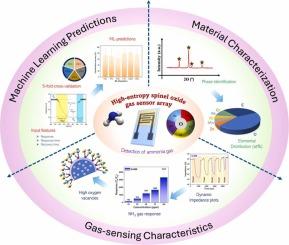Ultra-high ammonia gas response of phase-stabilized (Fe0.2Ni0.2Cr0.2Mn0.2Zn0.2)3O4-δ high-entropy spinel oxide sensor array and its machine learning predictions
IF 6.3
2区 材料科学
Q2 CHEMISTRY, PHYSICAL
引用次数: 0
Abstract
In this work, the gas sensing performance of phase-stabilized (FeNiMnZnCr)3O4 high-entropy spinel oxide (HSO) gas-sensors via screen-printing were investigated, where the HSO powders were synthesized via solution combustion synthesis (SCS) using three different fuels: citric acid, urea, and glucose. Although all HSO powders were obtained at 500 °C, the formation of stable spinel phase was evidenced at 600 °C. Among all fabricated sensors, G-800 gas sensor depicted a stable ultra-high response of ∼3471 towards 100 ppm of ammonia gas along with a notable response of ∼162 even at 10 ppm (where G means glucose and 800 represents calcination temperature in °C) and it demonstrated a strong device-to-device reproducibility with stability of ∼35 days. A synergy of crystallinity and increased porosities from XRD and FESEM micrographs resulted in ultra-high gas-response towards ammonia gas compared to volatile organic compounds such as formaldehyde, methanol, and ethanol). The presence of defect band and oxygen vacancies observed from the Raman and XPS analysis, were complemented by the presence of porosities confirmed from BET surface area analysis. Subsequently, the machine learning (ML) algorithms are applied on sensor signals to estimate the concentration of ammonia gas, and among all the ML classifiers, RFC gave reasonably better predictions in three concentrations regimes with a good classification accuracy of 93.3 ± 5.3 %, 90 ± 7.5 %, and 83.3 ± 13.1 % for G-600, G-700, and G-800, respectively. The proposed ML studies enable accurate detection of hazardous ammonia levels using HSO-based sensors, showing strong potential for integration into diagnostic platforms targeting ammonia breath markers.

相稳定(Fe0.2Ni0.2Cr0.2Mn0.2Zn0.2)3O4-δ高熵尖晶石氧化物传感器阵列的超高氨气响应及其机器学习预测
在本工作中,通过丝网印刷研究了相稳定(FeNiMnZnCr)3O4高熵尖晶石氧化物(HSO)气体传感器的气敏性能,其中HSO粉末通过溶液燃烧合成(SCS)合成,使用三种不同的燃料:柠檬酸,尿素和葡萄糖。虽然所有的HSO粉末都是在500°C时得到的,但在600°C时证明了稳定尖晶石相的形成。在所有制造的传感器中,G-800气体传感器对100 ppm氨气的稳定超高响应为~3471,即使在10 ppm (G表示葡萄糖,800表示°C的煅烧温度)的响应也显着为~162,并且具有很强的设备到设备的再现性,稳定性为~35天。从XRD和FESEM显微图中可以看出,结晶度和孔隙度增加的协同作用导致了与甲醛、甲醇和乙醇等挥发性有机化合物相比,氨气具有超高的气体响应。通过拉曼和XPS分析观察到的缺陷带和氧空位的存在,与BET表面积分析证实的孔隙的存在相辅相成。随后,将机器学习(ML)算法应用于传感器信号来估计氨气浓度,在所有ML分类器中,RFC在三种浓度下给出了较好的预测,G-600、G-700和G-800的分类准确率分别为93.3±5.3%、90±7.5%和83.3±13.1%。提议的ML研究能够使用基于hso的传感器准确检测危险氨水平,显示出集成到针对氨呼吸标记物的诊断平台的强大潜力。
本文章由计算机程序翻译,如有差异,请以英文原文为准。
求助全文
约1分钟内获得全文
求助全文
来源期刊

Journal of Alloys and Compounds
工程技术-材料科学:综合
CiteScore
11.10
自引率
14.50%
发文量
5146
审稿时长
67 days
期刊介绍:
The Journal of Alloys and Compounds is intended to serve as an international medium for the publication of work on solid materials comprising compounds as well as alloys. Its great strength lies in the diversity of discipline which it encompasses, drawing together results from materials science, solid-state chemistry and physics.
 求助内容:
求助内容: 应助结果提醒方式:
应助结果提醒方式:


